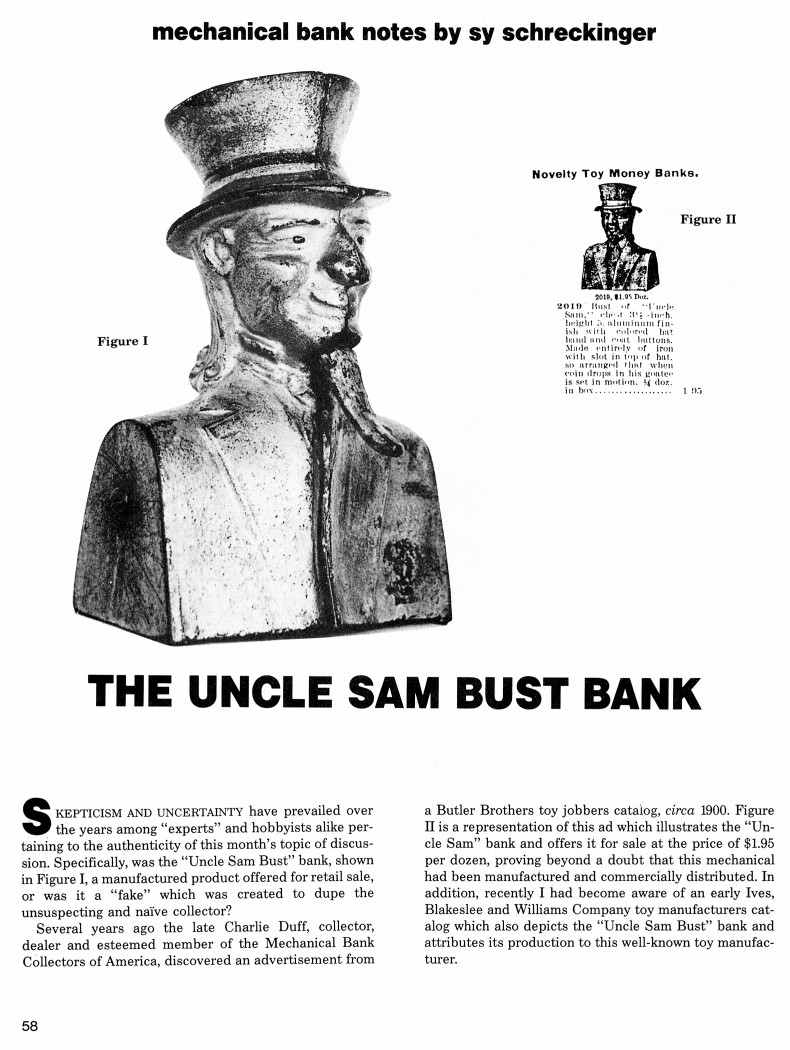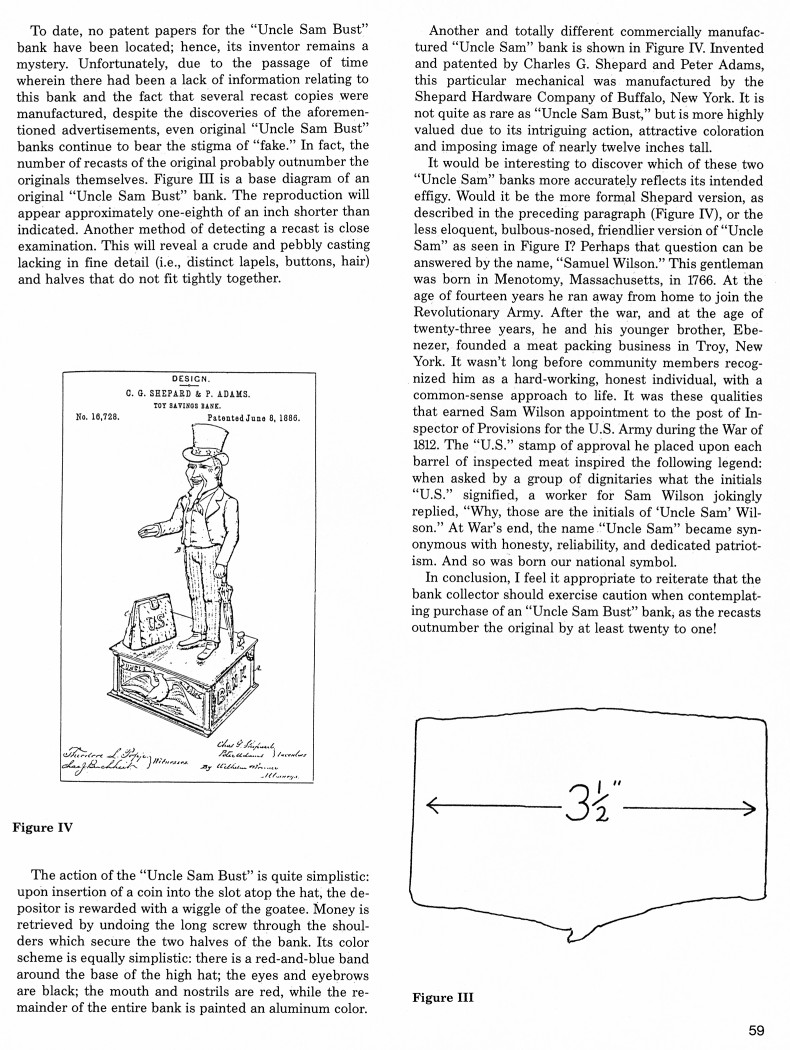|
The Uncle Sam Bust Bank
by Sy Schreckinger – ANTIQUE TOY WORLD Magazine – May, 1989
Skepticism and uncertainty have prevailed over the years among "experts"
and hobbyists alike pertaining to the authenticity of this month's topic
of discussion. Specifically, was the "Uncle Sam Bust" bank, shown in
Figure I, a manufactured product offered for retail sale, or was it a
"fake" which was created to dupe the unsuspecting and naive collector?
Several years ago the late Charlie Duff, collector, dealer and
esteemed member of the Mechanical Bank Collectors of America, discovered
an advertisement from a Butler Brothers toy jobbers catalog, circa 1900.
Figure II is a representation of this ad which illustrates the "Uncle Sam"
bank and offers it for sale at the price of $1.95 per dozen, proving
beyond a doubt that this mechanical had been manufactured and commercially
distributed. In addition, recently I had become aware of an early Ives,
Blakeslee and Williams Company toy manufacturers catalog which also
depicts the "Uncle Sam Bust" bank and attributes its production to this
well-known toy manufacturer.
To date, no patent papers for the "Uncle Sam Bust" bank have been
located; hence, its inventor remains a mystery. Unfortunately, due to the
passage of time wherein there had been a lack of information relating to
this bank and the fact that several recast copies were manufactured,
despite the discoveries of the aforementioned advertisements, even
original "Uncle Sam Bust" banks continue to bear the stigma of "fake." In
fact, the number of recasts of the original probably outnumber the
originals themselves. Figure III is a base diagram of an original "Uncle
Sam Bust" bank. The reproduction will appear approximately one-eighth of
an inch shorter than indicated. Another method of detecting a recast is
close examination. This will reveal a crude and pebbly casting lacking in
fine detail (i.e., distinct lapels, buttons, hair) and halves that do not
fit tightly together.
The action of the "Uncle Sam Bust" is quite simplistic: upon
insertion of a coin into the slot atop the hat, the depositor is rewarded
with a wiggle of the goatee. Money is retrieved by undoing the long screw
through the shoulders which secure the two halves of the bank. Its color
scheme is equally simplistic: there is a red-and-blue band around the base
of the high hat; the eyes and eyebrows are black; the mouth and nostrils
are red, while the remainder of the entire bank is painted an aluminum
color.
Another and totally different commercially manufactured "Uncle Sam"
bank is shown in Figure IV. Invented and patented by Charles G. Shepard
and Peter Adams, this particular mechanical was manufactured by the
Shepard Hardware Company of Buffalo, New York. It is not quite as rare as
"Uncle Sam Bust," but is more highly valued due to its intriguing action,
attractive coloration and imposing image of nearly twelve inches tall.
It would be interesting to discover which of these two "Uncle Sam"
banks more accurately reflects its intended effigy. Would it be the more
formal Shepard version, as described in the preceding paragraph (Figure
IV), or the less eloquent, bulbous-nosed, friendlier version of "Uncle
Sam" as seen in Figure I? Perhaps that question can be answered by the
name, "Samuel Wilson." This gentleman was born in Menotomy, Massachusetts,
in 1766. At the age of fourteen years he ran away from home to join the
Revolutionary Army. After the war, and at the age of twenty-three years,
he and his younger brother, Ebenezer, founded a meat packing business in
Troy, New York. It wasn't long before community members recognized him as
a hard-working, honest individual, with a common-sense approach to life.
It was these qualities that earned Sam Wilson appointment to the post of
Inspector of Provisions for the U.S. Army during the War of 1812. The
"U.S." stamp of approval he placed upon each barrel of inspected meat
inspired the following legend: when asked by a group of dignitaries what
the initials "U.S." signified, a worker for Sam Wilson jokingly replied,
"Why, those are the initials of 'Uncle Sam' Wilson." At War's end, the
name "Uncle Sam" became synonymous with honesty, reliability, and
dedicated patriotism. And so was born our national symbol.
In conclusion, I feel it appropriate to reiterate that the bank
collector should exercise caution when contemplating purchase of an
"Uncle Sam Bust" bank, as the recasts outnumber the original by at least
twenty to one!
|


